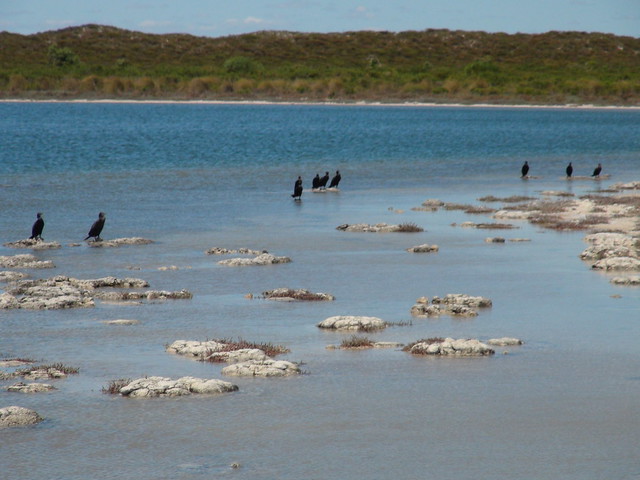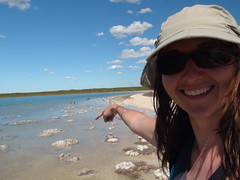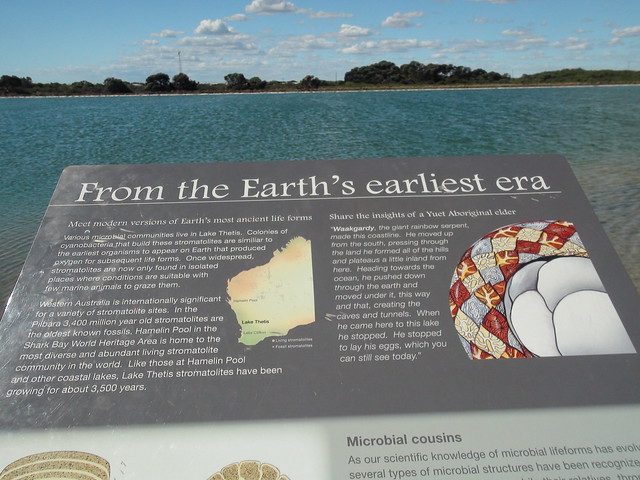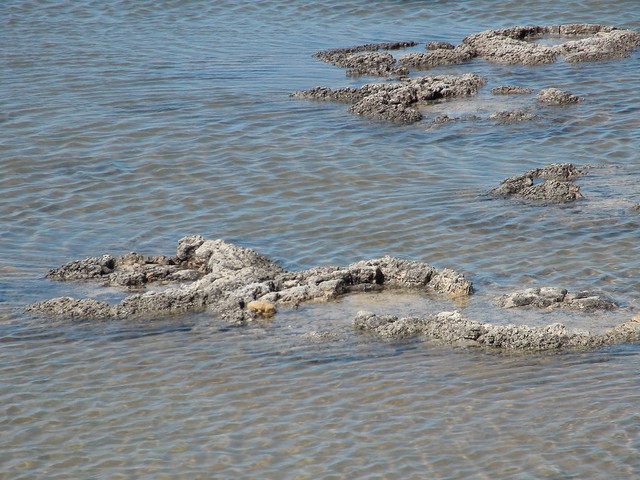Stromatolites
Sometimes scientists tell us about things which are pretty hard to believe. I am wary of complicated calculations and annoying graphs embedded in flowery jargon. I dislike being manipulated, I have to understand! It costs me a bit: I have to insist, ask for repetition and clarification until it makes sense. But sometimes these scientific demonstrations force me to question some of my certainties…. Not easy! For example, there’s the story about algae that would be at the origin of the ozone layer establishment… So far, I was living with a completely different story about the origin of the world that suited me well! It took me some time to come to terms with these topics of Evolution and fall into fascination. I committed to narrate my discoveries, even those which caused me headaches. Today I am telling you about stromatolites, stones like no other!
On the road
In Western Australia, on the way back from a visit to Port Gregory and the discovery of a pink lake1, we drive peacefully along the Indian Ocean Drive to go back to Perth.
The road is beautiful along the coast. No need for a GPS, Perth is straight ahead! Suddenly, Anne-Gaëlle takes a sharp turn to the left and enters a cross-road. I initially thought of a kangaroo attack but it was actually a detour for seeing stones. A lake with big stones in it to be quite exact.

We stand on the banks of Lake Thetis. Well, we are tranquil: except for a few cormorants, the place is quite desert. The trail is well maintained, it seems this is a place that people visit. Is it a place of worship or sacred lake?
“Jacqueline Algane: So, what do we do now?
- Anne-Gaëlle: We pay respect…
Jacqueline: Pardon me? “
With a big smile, Anne-Gaëlle recalls my skepticism at the beginning of our trip. That was when Dr. Sahoo told me about the role of algae in the creation of the atmosphere billions of years ago.
“Anne-Gaëlle: Jacqueline, do you remember? You were wondering who could be the witnesses of that time. I’m very pleased to introduce them to you here!
- Jacqueline: The cormorants?!
- Anne-Gaëlle: No, the rocks!”

Rocks. The sun is pretty hot in the region, Anne-Gaëlle may be having a heatstoke.
I would worry a little but she actually seems pretty fine, she looks as enthusiastic as she would be for a rock concert (isn’t it one?).
I leave her jumping around and I turn to the information boards of the site.
How stromatolites are born
These large stones are stromatolites. The word comes from the greek strôma, meaning rug, and lithos, meaning stone.

Stromatolites of Lake Thetis
According to the information in front of me, stromatolites are structures which have a biogenic (i.e. resulting from the activity of a living organism) and sedimentary origin. These formations are made of both living matter (bacteria and cyanobacteria2) and limestone.
Stromatolites are not alive themselves: only the top layer is alive. This fragile layer of microorganisms is responsible for sediment precipitation.
These living organisms are colonies of cyanobacteria: while developing, they secrete a sticky film of mucus which traps suspended particles. Other bacteria present in these communities help turn calcium to limestone.
This leads to the formation of a sedimentary layer which persists after the death of these microorganisms: they leave behind a hard material composed of rock and sand. Under the living rug of bacteria, rock layers continue to increase as bacteria continue to live, reproduce and grow on top of the previous populations. Little by little, in the course of the development in successive layers (strata), the mineral sheets build the stromatolite. Their growth is very slow.
Depending on their shape, a distinction can be made between stromatolites and thrombolites.

Living fossils?
Fossil stromatolites have been found in rocks in several regions of the world. Identified thanks to their characteristic sheet structure, modern dating methods3 have made it possible to evaluate their age. A recent scientific study of 20164 revealed a fossil stromatolite from Greenland5 dating back to 3.7 billion years which makes it so far one of the oldest indicators of life on the surface of the Earth6! This one beats a previous record set by a 200 million years younger stromatolite found in the Pilbarra region of Western Australia.
The microorganisms that construct the current stromatolites are cyanobacteria species similar to those from 3.7 billion years ago. That’s why they are sometimes described as living fossils.

Thetis Lake Information board mentioning an Aboriginal Legend
3.7 billion years… wow, that helps me put our existence into perspective.
That’s not all! The discovery of these modern examples helped scientists to understand the importance of these microorganisms in the environment and to unravel the long history of life on Earth. This also helps us put our role into perspective!
Crucial cyanobacteria
Cyanobacteria played a fundamental role in the evolution of life. Here is a brief outline (but Earth’s history, worthy of the most beautiful Hollywood scenarios, deserves more attention7):
-
Cyanobacteria would have appeared in the oceans 3.7 billion years ago. Because they had the brilliant idea of inventing photosynthesis, they fixed carbon and also rejected “a waste”, oxygen O2.
-
This oxygen first oxidized all the iron present in the oceans. This formed iron oxides (hematites, magnetite) which precipitated and accumulated at the bottom of the seas, in the rocks.
-
After some time (more than a billion years!), all the iron is oxidized. After depletion of the marine iron, the oxygen spreads from the ocean to the atmosphere (at a time when the Earth’s atmosphere was hostile to life!).
-
The proliferation and dominance of cyanobacteria leads to an increase of the oxygen content in the atmosphere and the establishment of the ozone layer8. The ozone layer reflects the sun’s rays. By absorbing much of the ultraviolet radiation, conditions on the Earth’s surface become more favorable to the development of other forms of life9. As genetic mutations evolve, Evolution leads to the emergence of organisms adapted to these living conditions and to the increase of biodiversity!
Finally, these cyanobacteria modified their environment by “polluting” the Earth with oxygen for nearly 2 billion years! And I owe them my presence on the shores of Lake Thetis.
In the past, these cyanobacteria were responsible of the capture of carbon and calcium in rocks (this is also called sequestration because the carbon and the calcium are then stuck in the rocks and can not escape!). Despite their slow growth, they are also the source of important rock formations.
Today, living examples of these once dominant organisms are limited to only a few places in Australia, Egypt, South Africa, the Bahamas, Brazil, among others.

Tranquil stromatolites, similar to those which transformed the planet some 3 billion years ago
Pilgrimage
The stromatolites of Thetis Lake are about 3370 years old. I will need a little time to digest all this information. Adam and Eve have a slightly sexier image than these stromatolites. But the “quiet force” of these rocks grant them a lot of class!
I did not expect such a pilgrimage. Near Lake Thetis, closest to this testament of the past, I take the time to greet a form of life to which we owe our presence on Earth. I would stay there longer watching the stones and deconstruct my certainties but the environmental conditions and the sensitive skin of Anne-Gaëlle push us to shelter from the UV rays!
By the way, speaking of protection against UV rays, some Algonauts work on macroalgae molecules with photoprotective properties! A fine result of the adaptation of organisms and Evolution!
Learn more
With an approaching storm, we were advised to return south. So we could not go a little further north to Shark Bay, where a famous and spectacular colony of stromatolites resides!
Footnotes:
-
The Pink Lake: yes, for that too, it took Jacqueline to see it to believe it … To follow in another story! A few hints by taking a look here ↩
-
If you do not remember what a cyanobacterium is, do not be lazy and go back to the previous chapter! ↩
-
Datation based on the measurement of atoms in these samples. ↩
-
Nutman, A.P., Bennett, V. C., Friend, C.R., Van Kranendonk, M.J., and Chivas, A.R. (2016). Rapid emergence of life shown by discovery of 3,700-million-year-old microbial structures. Nature, 537 (7621), 535-538. Link ↩
-
This discovery was made in an area where the rocks have been brought to light because of the melting of ice, as a result of global warming! ↩
-
An even more ancient trace of life? A New York Times article on March 1, 2017. ↩
-
Have a look to these synthetic documentaries on the history of the Earth, it is fascinating! Here for example! ↩
-
The ozone layer establishment results from the action of UV radiation from solar radiation on oxygen molecules at high-altitude ↩
-
DNA, a molecule that supports genetic information, is sensitive to ultraviolet rays. They are mutagenic agents: they damage the DNA of the cells, causing perturbation of their biological activities (which can evolve into cancer) or destruction (sunburn). ↩